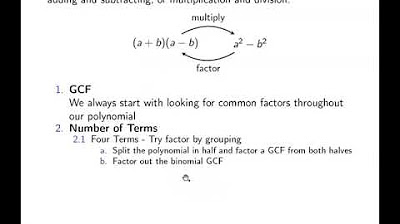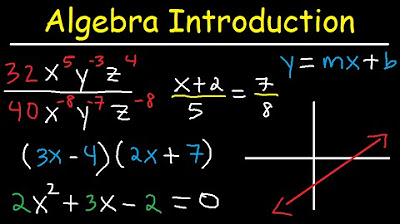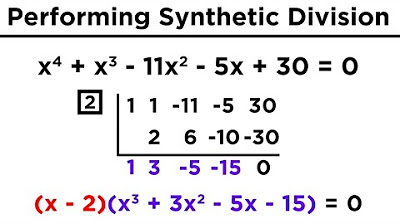Introduction to Polynomials
TLDRThis script introduces polynomials, which are algebraic expressions containing variables raised to positive whole number exponents. It covers the structure and conventions of writing polynomials, including naming monomials, binomials, trinomials, and expressions by their degree. It explains how to evaluate polynomials by plugging in values. Finally, it notes that while evaluating polynomials is straightforward, solving polynomial equations can become extremely complicated at higher degrees, requiring intricate techniques that mathematicians devote lifetimes to studying.
Takeaways
- 😀 Polynomials are expressions with variables raised to positive whole number exponents
- 😎 The order of terms in a polynomial goes from highest to lowest exponent
- 📚 The degree of a polynomial is the exponent on its leading term
- 🤓 Quadratic polynomials have degree 2, cubic have degree 3
- 🧐 A polynomial can be missing terms, which are treated as 0
- 👍 Evaluating polynomials involves plugging in the value for the variable
- 😕 Solving polynomial equations can get extremely complicated
- 🤯 Brilliant mathematicians work on solving complex polynomials their whole lives
- 😀 We will start by focusing on the basics of working with polynomials
- 🤠 Put some reverence for algebra's complexity in your pocket as we continue
Q & A
What are polynomials?
-Polynomials are algebraic expressions that contain an unknown variable raised to various positive whole number exponents, such as x^2 + 4x + 10.
What are the key components that make up a polynomial?
-The key components are: a variable (x), exponents representing the powers the variable is raised to, coefficients multiplying each term, constants or numbers with no variable.
How are the terms in a polynomial typically ordered?
-By convention, polynomial terms are listed in decreasing order of their exponents.
What is the degree of a polynomial?
-The degree of a polynomial refers to the highest power or exponent present for the variable term. For example, x^3 + 2x + 5 has degree 3.
What are some special names given to low-degree polynomials?
-A monomial has one term, a binomial has two terms, and a trinomial has three terms. Higher degree polynomials do not have special names.
Do polynomials have to contain all possible terms?
-No, polynomials can have missing terms, which are treated as if they have a coefficient of 0.
How do you evaluate a polynomial for a given value of x?
-To evaluate, substitute the given x-value for x in the polynomial expression and compute using normal algebraic order of operations.
Why can polynomial equations be hard to solve for x?
-The presence of multiple x terms with exponents means we cannot use typical algebraic solution methods to isolate x on one side.
What are some ways to solve polynomial equations?
-Factoring, completing the square, using the quadratic formula, synthetic division, and numerical approximation methods can be used to solve certain polynomial equations.
How complex can polynomial solutions get?
-Very complex! As the degree increases, the solutions can become extremely intricate, requiring advanced techniques that mathematicians research and specialize in.
Outlines
😃 Introducing Polynomials
This paragraph introduces polynomials, explaining that they are algebraic expressions containing an unknown variable raised to positive whole number exponents. It gives examples of monomials, binomials, and trinomials based on the number of terms. It also notes conventions like arranging terms by decreasing exponents and defining the degree of a polynomial.
😄 Evaluating and Solving Polynomials
This paragraph contrasts evaluating and solving polynomials. Evaluating for a given value of the variable is straightforward. But solving to find the variable's values that satisfy the equation can be extremely complicated, requiring advanced techniques. It notes reverence for the deep complexity algebra enables while setting up forthcoming coverage of the basics.
Mindmap
Keywords
💡polynomial
💡degree
💡monomial
💡binomial
💡trinomial
💡evaluate
💡solve
💡exponent
💡coefficient
💡term
Highlights
Polynomials are expressions that contain an unknown raised to various positive whole number exponents.
Polynomials follow a general form with decreasing exponents and a constant term.
Polynomials with one term are monomials, two terms are binomials, and three terms are trinomials.
The highest power present in a polynomial is called its degree.
We can evaluate a polynomial by plugging in a value for the variable.
Solving polynomial equations can be extremely complicated compared to other algebraic equations.
Even brilliant mathematicians spend lifetimes trying to figure out ways to solve complex polynomials.
It's good to show some reverence for the deep complexity algebra is capable of.
There are a variety of ways to solve polynomial equations that we will learn.
If there is just one term, like two X, it’s a monomial.
We typically only interact with expressions that go up to a power of three or four.
Polynomials don’t have to have all the possible terms.
Polynomials get much more complex than this, their solutions become so intricate.
Strategies we have learned thus far will not work to solve polynomials.
Put reverence for algebra's complexity in your pocket as we've got more polynomial work.
Transcripts
Browse More Related Video

Adding and Subtracting Polynomials

Ch. 1.3 Algebraic Expressions

Algebra Introduction - Basic Overview - Online Crash Course Review Video Tutorial Lessons

Exponents Explained!

Solving Higher-Degree Polynomials by Synthetic Division and the Rational Roots Test

Algebra Basics: What Are Polynomials? - Math Antics
5.0 / 5 (0 votes)
Thanks for rating: